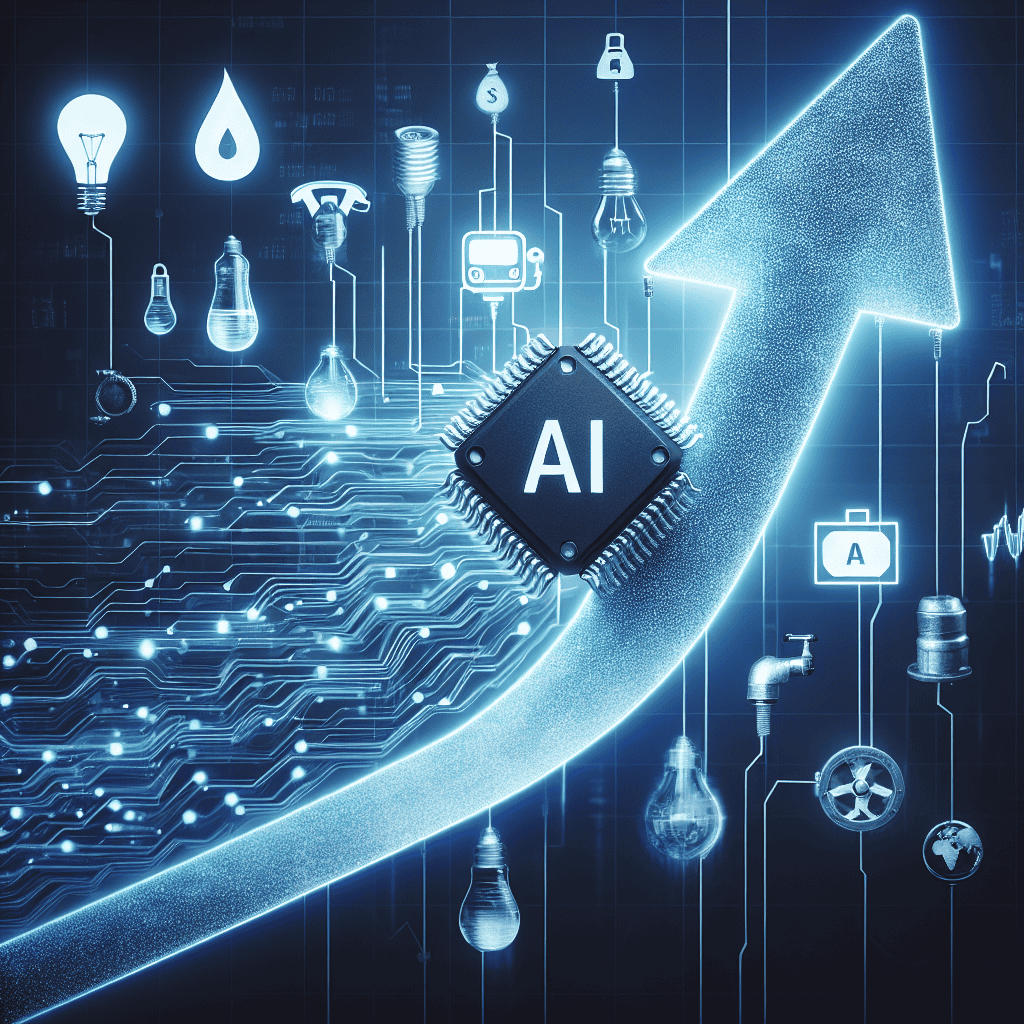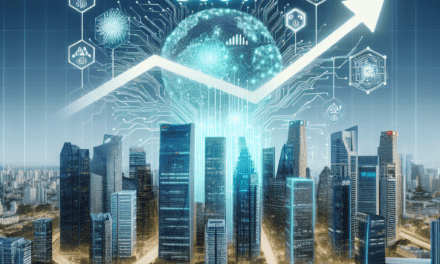“Powering the Future: AI Sparks a New Era in Utility Market Growth”
Introduction
In recent months, the utilities sector has experienced a significant surge, outpacing broader market trends, largely fueled by growing enthusiasm for AI-driven electricity demand. As artificial intelligence technologies continue to advance and integrate into various industries, the demand for electricity has seen a notable increase, driven by the energy-intensive nature of AI operations such as data centers, machine learning processes, and cloud computing. This heightened demand has prompted utilities companies to innovate and expand their capacity, investing in smart grid technologies and sustainable energy solutions to meet the evolving needs of AI applications. Consequently, investors are increasingly optimistic about the sector’s potential for growth, viewing utilities as a critical backbone in the AI revolution. This enthusiasm is reflected in the rising stock prices and market valuations of utility companies, positioning them as key players in the future of energy consumption and technological advancement.
Impact Of AI On Electricity Demand And Utility Markets
The rapid advancement of artificial intelligence (AI) technologies has begun to significantly influence various sectors, with the utility markets experiencing a notable surge. This surge is primarily driven by the increasing electricity demand associated with AI applications, which are becoming integral to numerous industries. As AI systems require substantial computational power, the demand for electricity has escalated, prompting utilities to adapt and expand their capabilities to meet these new requirements. Consequently, the utility markets are witnessing a transformation, characterized by both opportunities and challenges.
To begin with, the proliferation of AI technologies has led to a substantial increase in data processing needs. AI applications, such as machine learning algorithms and neural networks, necessitate vast amounts of computational resources, which in turn require significant electrical power. Data centers, the backbone of AI operations, are expanding rapidly to accommodate this growing demand. These centers are energy-intensive, consuming large quantities of electricity to power servers and maintain optimal operating conditions. As a result, utility companies are experiencing heightened demand, prompting them to enhance their infrastructure and invest in more sustainable energy solutions.
Moreover, the integration of AI into the utility sector itself is fostering efficiency and innovation. Utilities are leveraging AI to optimize grid management, predict maintenance needs, and enhance energy distribution. By employing AI-driven analytics, utilities can better forecast electricity demand, thereby reducing waste and improving service reliability. This not only benefits the utilities by lowering operational costs but also contributes to a more sustainable energy landscape. The ability to predict and respond to demand fluctuations in real-time is revolutionizing how utilities operate, making them more agile and responsive to consumer needs.
In addition to operational improvements, the surge in electricity demand driven by AI is influencing market dynamics. Utilities are exploring new business models to capitalize on this trend, such as offering tailored energy solutions for data centers and AI-driven enterprises. This shift is creating a competitive landscape where utilities must innovate to attract and retain customers. Furthermore, the increased demand for electricity is prompting investments in renewable energy sources, as utilities strive to meet sustainability goals and reduce carbon footprints. This transition towards cleaner energy is not only environmentally beneficial but also aligns with the growing consumer preference for sustainable practices.
However, the rapid growth in electricity demand also presents challenges. Utilities must navigate the complexities of scaling infrastructure while ensuring grid stability and reliability. The integration of renewable energy sources, while advantageous, introduces variability that must be managed effectively. Additionally, regulatory frameworks need to evolve to accommodate the changing landscape, ensuring that utilities can innovate while maintaining compliance with environmental and safety standards.
In conclusion, the impact of AI on electricity demand and utility markets is profound and multifaceted. As AI technologies continue to advance, the demand for electricity will likely persist, driving utilities to innovate and adapt. The opportunities for growth and efficiency are significant, yet they come with challenges that require strategic planning and investment. By embracing AI-driven solutions and sustainable practices, utilities can not only meet the rising demand but also contribute to a more resilient and environmentally conscious energy future. As the utility markets surge ahead, driven by AI-driven electricity demand enthusiasm, the sector stands at the forefront of a transformative era, poised to redefine the intersection of technology and energy.
How AI Is Revolutionizing The Utility Sector
The utility sector, traditionally characterized by its steady and predictable growth, is experiencing a remarkable transformation driven by the integration of artificial intelligence (AI). This technological revolution is not only reshaping how utilities operate but also propelling them ahead of broader market trends. As AI continues to evolve, its impact on electricity demand and supply management is becoming increasingly profound, offering utilities unprecedented opportunities to enhance efficiency, reliability, and sustainability.
At the heart of this transformation is the ability of AI to process vast amounts of data with remarkable speed and accuracy. Utilities generate and collect enormous volumes of data from various sources, including smart meters, grid sensors, and weather forecasts. AI algorithms can analyze this data in real-time, providing utilities with actionable insights that were previously unattainable. Consequently, utilities can optimize their operations, reduce costs, and improve service delivery. For instance, AI-driven predictive maintenance allows utilities to anticipate equipment failures before they occur, minimizing downtime and enhancing grid reliability.
Moreover, AI is playing a pivotal role in demand forecasting, a critical aspect of utility management. Accurate demand forecasting enables utilities to balance supply and demand more effectively, reducing the need for costly and environmentally harmful peaking power plants. AI models can predict electricity demand with greater precision by considering a multitude of factors, such as historical consumption patterns, weather conditions, and even social events. This enhanced forecasting capability not only ensures a more stable grid but also supports the integration of renewable energy sources, which are inherently variable in nature.
In addition to operational efficiencies, AI is driving innovation in customer engagement and energy management. Utilities are leveraging AI to offer personalized energy solutions to consumers, empowering them to make informed decisions about their energy usage. Through AI-powered platforms, customers can receive tailored recommendations on how to reduce their energy consumption and costs. This not only enhances customer satisfaction but also contributes to broader energy conservation efforts.
Furthermore, AI is facilitating the transition towards a more decentralized energy system. The rise of distributed energy resources, such as rooftop solar panels and home battery storage, presents both challenges and opportunities for utilities. AI can help manage these distributed resources by optimizing their integration into the grid, ensuring that they complement rather than disrupt traditional energy sources. This capability is crucial as utilities strive to accommodate the growing demand for clean and sustainable energy solutions.
As AI continues to revolutionize the utility sector, it is also attracting significant investment and interest from stakeholders across the industry. Utilities are increasingly partnering with technology companies to develop and deploy AI solutions, recognizing the potential for AI to drive competitive advantage. This collaboration is fostering a culture of innovation within the sector, encouraging utilities to explore new business models and revenue streams.
In conclusion, the integration of AI into the utility sector is not merely a technological advancement; it represents a paradigm shift in how utilities operate and interact with their customers. By harnessing the power of AI, utilities are not only improving their operational efficiency and reliability but also positioning themselves at the forefront of the energy transition. As AI-driven electricity demand enthusiasm continues to surge, the utility sector is poised to lead the way in creating a more sustainable and resilient energy future.
The Role Of AI In Enhancing Energy Efficiency
The integration of artificial intelligence (AI) into the energy sector is revolutionizing the way utilities operate, leading to a surge in market performance driven by AI-driven electricity demand enthusiasm. As the world increasingly focuses on sustainability and efficiency, AI emerges as a pivotal tool in enhancing energy efficiency, offering utilities the ability to optimize operations, reduce costs, and meet the growing demand for electricity in a more sustainable manner. This transformation is not only reshaping the energy landscape but also providing a competitive edge to utilities that embrace these advanced technologies.
AI’s role in enhancing energy efficiency is multifaceted, encompassing various aspects of utility operations. One of the primary applications of AI in this sector is in demand forecasting. By analyzing vast amounts of data from historical usage patterns, weather forecasts, and even social trends, AI algorithms can predict electricity demand with remarkable accuracy. This allows utilities to better manage their resources, ensuring that supply meets demand without overproducing, which in turn reduces waste and enhances overall efficiency. Moreover, accurate demand forecasting helps in minimizing the reliance on fossil fuel-based peaking power plants, thereby reducing carbon emissions.
In addition to demand forecasting, AI is instrumental in optimizing grid operations. The modern electricity grid is a complex network that requires constant monitoring and adjustment to maintain stability and efficiency. AI systems can process real-time data from sensors across the grid, identifying potential issues before they escalate into significant problems. This proactive approach not only prevents outages but also extends the lifespan of grid infrastructure by reducing wear and tear. Furthermore, AI-driven grid management facilitates the integration of renewable energy sources, such as solar and wind, by efficiently balancing their intermittent nature with traditional power generation methods.
Another significant contribution of AI to energy efficiency is in the realm of energy storage. As renewable energy sources become more prevalent, the need for effective energy storage solutions becomes increasingly critical. AI can optimize the charging and discharging cycles of batteries, ensuring that stored energy is used in the most efficient manner possible. This not only maximizes the utility of renewable energy but also reduces the need for additional power generation during peak demand periods.
Moreover, AI is transforming the way consumers interact with energy. Smart meters and AI-driven home energy management systems provide consumers with real-time insights into their energy usage, empowering them to make informed decisions about their consumption habits. By identifying patterns and suggesting adjustments, these systems can significantly reduce household energy consumption, contributing to overall energy efficiency.
The enthusiasm surrounding AI-driven electricity demand is also reflected in the financial markets, where utilities that leverage AI technologies are experiencing a surge in investor interest. This is largely due to the potential for cost savings and increased operational efficiency that AI offers, which can translate into higher profit margins and a more sustainable business model. As a result, utilities that are at the forefront of AI adoption are not only enhancing their operational capabilities but also positioning themselves as leaders in the transition to a more sustainable energy future.
In conclusion, the role of AI in enhancing energy efficiency is becoming increasingly vital as utilities strive to meet the challenges of modern energy demands. Through improved demand forecasting, optimized grid operations, advanced energy storage solutions, and enhanced consumer engagement, AI is driving a new era of efficiency and sustainability in the energy sector. As this trend continues, utilities that embrace AI technologies are likely to maintain their competitive edge, benefiting both their bottom line and the environment.
AI-Driven Innovations In Renewable Energy Integration

The integration of artificial intelligence (AI) into the renewable energy sector is revolutionizing the way utilities operate, leading to a surge in market performance driven by heightened electricity demand. As the world increasingly shifts towards sustainable energy sources, AI-driven innovations are playing a pivotal role in optimizing the integration of renewable energy into existing power grids. This transformation is not only enhancing the efficiency and reliability of energy systems but also propelling utilities ahead of traditional market trends.
One of the primary ways AI is influencing the renewable energy sector is through predictive analytics. By analyzing vast amounts of data from weather patterns, energy consumption trends, and grid performance, AI systems can accurately forecast energy production and demand. This capability allows utilities to better manage the intermittent nature of renewable energy sources such as solar and wind. For instance, when AI predicts a period of low wind or solar output, utilities can proactively adjust their operations to ensure a stable energy supply, thereby minimizing disruptions and maintaining grid stability.
Moreover, AI is facilitating the integration of distributed energy resources (DERs) into the grid. DERs, which include rooftop solar panels, battery storage systems, and electric vehicles, are becoming increasingly prevalent. AI algorithms can optimize the operation of these resources by determining the most efficient times to store or release energy, thus enhancing the overall efficiency of the grid. This optimization not only reduces energy waste but also lowers costs for both utilities and consumers, making renewable energy more economically viable.
In addition to optimizing energy production and consumption, AI is also enhancing the maintenance and operation of renewable energy infrastructure. Through the use of machine learning algorithms, AI can predict equipment failures before they occur, allowing for timely maintenance and reducing downtime. This predictive maintenance capability is particularly valuable for wind turbines and solar panels, where unexpected failures can lead to significant energy losses. By ensuring that equipment operates at peak efficiency, AI helps maximize the output of renewable energy installations.
Furthermore, AI-driven innovations are enabling more effective demand response strategies. By analyzing real-time data on energy usage, AI systems can identify patterns and suggest adjustments to energy consumption during peak demand periods. This capability allows utilities to implement demand response programs that incentivize consumers to reduce their energy usage during times of high demand, thereby alleviating stress on the grid and reducing the need for costly peaking power plants.
As AI continues to advance, its role in the renewable energy sector is expected to grow even more significant. The development of more sophisticated algorithms and the increasing availability of data will further enhance the ability of AI to optimize energy systems. This progress will likely lead to even greater efficiencies and cost savings, further driving the adoption of renewable energy sources.
In conclusion, AI-driven innovations are transforming the renewable energy sector by optimizing the integration of sustainable energy sources into the grid. Through predictive analytics, enhanced maintenance, and effective demand response strategies, AI is enabling utilities to operate more efficiently and reliably. As a result, utilities are surging ahead of traditional market trends, driven by the growing enthusiasm for AI-driven electricity demand solutions. This transformation not only supports the global transition to renewable energy but also underscores the critical role of AI in shaping the future of the energy industry.
Challenges And Opportunities For Utilities In The AI Era
The rapid advancement of artificial intelligence (AI) technologies has ushered in a new era of opportunities and challenges for the utilities sector. As AI-driven electricity demand continues to surge, utilities are finding themselves at the forefront of a transformative period that promises both significant growth and complex hurdles. This dynamic landscape is characterized by the increasing integration of AI in various industries, which in turn drives a heightened demand for electricity. Consequently, utilities are compelled to adapt swiftly to meet these evolving needs while ensuring reliability and sustainability.
One of the primary challenges utilities face in this AI era is the need to upgrade and modernize their infrastructure. The traditional grid systems, designed for a more predictable and stable demand, are now being tested by the fluctuating and often unpredictable electricity requirements driven by AI applications. For instance, data centers, which are the backbone of AI operations, consume vast amounts of electricity. As AI technologies become more prevalent, the demand for data processing and storage capabilities grows, leading to increased energy consumption. Utilities must therefore invest in smart grid technologies that can efficiently manage and distribute electricity to meet these demands.
Moreover, the integration of renewable energy sources into the grid presents both an opportunity and a challenge. On one hand, renewables offer a sustainable solution to meet the rising electricity demand. On the other hand, their intermittent nature requires utilities to develop sophisticated energy management systems that can balance supply and demand effectively. AI can play a crucial role in this context by optimizing energy distribution and predicting consumption patterns, thereby enhancing grid stability and efficiency.
In addition to infrastructure challenges, utilities must also navigate regulatory and policy landscapes that are evolving in response to AI-driven electricity demand. Governments and regulatory bodies are increasingly focusing on sustainability and carbon reduction goals, which necessitate a shift towards cleaner energy sources. Utilities are thus under pressure to align their operations with these objectives while maintaining profitability. This requires strategic planning and investment in innovative technologies that can reduce carbon footprints and improve energy efficiency.
Despite these challenges, the AI era presents significant opportunities for utilities to innovate and expand their services. By leveraging AI technologies, utilities can enhance their operational efficiency, reduce costs, and improve customer service. For example, AI-driven analytics can provide valuable insights into consumer behavior, enabling utilities to offer personalized energy solutions and optimize pricing strategies. Furthermore, AI can facilitate predictive maintenance of infrastructure, reducing downtime and extending the lifespan of critical assets.
The transition to an AI-driven electricity landscape also opens up new business models for utilities. As the demand for electric vehicles (EVs) grows, utilities can explore opportunities in EV charging infrastructure and services. Additionally, the proliferation of smart home technologies offers utilities the chance to engage with consumers in novel ways, providing integrated energy management solutions that enhance convenience and sustainability.
In conclusion, the AI era presents a complex yet promising future for the utilities sector. While the challenges of modernizing infrastructure, integrating renewables, and navigating regulatory changes are significant, the opportunities for innovation and growth are equally compelling. By embracing AI technologies and adapting to the evolving electricity demand landscape, utilities can position themselves as key players in a sustainable and technologically advanced future. As they surge ahead of markets driven by AI-driven electricity demand enthusiasm, utilities have the potential to not only meet the needs of today but also shape the energy landscape of tomorrow.
Future Trends In AI-Driven Electricity Demand
The rapid advancement of artificial intelligence (AI) technologies is reshaping various sectors, with the utilities industry experiencing a significant transformation. As AI-driven electricity demand continues to rise, utilities are surging ahead of traditional markets, driven by the enthusiasm surrounding these technological innovations. This shift is not only altering the landscape of energy consumption but also prompting a reevaluation of how electricity is generated, distributed, and managed.
To begin with, the integration of AI into the utilities sector is revolutionizing the way electricity demand is forecasted and managed. AI algorithms, with their ability to process vast amounts of data, are enabling utilities to predict consumption patterns with unprecedented accuracy. This predictive capability allows for more efficient energy distribution, reducing waste and optimizing the use of resources. Consequently, utilities can better align their operations with real-time demand, minimizing the risk of overproduction and underutilization.
Moreover, AI-driven demand is fostering the development of smart grids, which are pivotal in modernizing electricity infrastructure. These grids leverage AI to enhance the reliability and efficiency of power delivery systems. By utilizing machine learning and data analytics, smart grids can identify and respond to fluctuations in electricity demand instantaneously. This responsiveness not only ensures a stable supply of electricity but also facilitates the integration of renewable energy sources, such as solar and wind, into the grid. As a result, utilities are better equipped to meet sustainability goals while maintaining operational efficiency.
In addition to improving grid management, AI is also playing a crucial role in demand-side management. Through the use of AI-powered devices and applications, consumers are becoming more active participants in managing their electricity usage. Smart meters and home automation systems, for instance, provide real-time insights into energy consumption, empowering consumers to make informed decisions about their usage patterns. This shift towards a more decentralized energy management model is encouraging utilities to adopt innovative strategies that cater to the evolving needs of their customers.
Furthermore, the enthusiasm surrounding AI-driven electricity demand is spurring investment in research and development. Utilities are increasingly collaborating with tech companies and research institutions to explore new AI applications that can enhance energy efficiency and sustainability. These partnerships are fostering a culture of innovation, leading to the creation of cutting-edge solutions that address the challenges posed by rising electricity demand. As a result, the utilities sector is becoming a hotbed for technological advancements, attracting significant attention from investors and stakeholders alike.
However, the surge in AI-driven electricity demand is not without its challenges. The increased reliance on AI technologies raises concerns about data privacy and security, as the vast amounts of data required for AI applications can be vulnerable to cyber threats. Utilities must therefore invest in robust cybersecurity measures to protect sensitive information and ensure the integrity of their systems. Additionally, the transition to AI-driven models necessitates significant infrastructure upgrades, which can be costly and time-consuming.
In conclusion, the utilities sector is experiencing a paradigm shift as AI-driven electricity demand propels it ahead of traditional markets. The integration of AI technologies is enhancing the efficiency and reliability of electricity supply, while also promoting sustainability and consumer empowerment. Despite the challenges associated with this transformation, the enthusiasm surrounding AI-driven demand is driving innovation and investment, positioning the utilities industry at the forefront of technological advancement. As AI continues to evolve, its impact on electricity demand will undoubtedly shape the future of energy management, offering exciting opportunities for growth and development in the years to come.
Case Studies: Utilities Adapting To AI-Driven Market Changes
In recent years, the utilities sector has experienced a remarkable transformation, driven largely by the burgeoning demand for electricity fueled by advancements in artificial intelligence (AI). As AI technologies become increasingly integrated into various industries, the demand for electricity has surged, prompting utilities to adapt swiftly to these market changes. This adaptation is not merely a response to increased consumption but also a strategic maneuver to harness AI’s potential in optimizing operations and enhancing service delivery.
One illustrative case study is that of a leading utility company that has embraced AI to revolutionize its energy distribution network. By deploying AI algorithms, the company has significantly improved its ability to predict energy demand patterns. This predictive capability allows for more efficient energy distribution, reducing waste and ensuring that supply meets demand with greater precision. Consequently, the company has not only enhanced its operational efficiency but also reduced costs, which has translated into more competitive pricing for consumers.
Moreover, AI-driven analytics have enabled utilities to better manage their infrastructure. For instance, predictive maintenance powered by AI has become a game-changer. By analyzing data from sensors embedded in equipment, utilities can anticipate failures before they occur, thereby minimizing downtime and extending the lifespan of critical infrastructure. This proactive approach not only ensures a more reliable energy supply but also optimizes resource allocation, further driving down operational costs.
In addition to operational efficiencies, AI has facilitated a more customer-centric approach within the utilities sector. By leveraging AI, utilities can offer personalized energy solutions tailored to individual consumption patterns. This customization is achieved through advanced data analytics, which provide insights into consumer behavior and preferences. As a result, utilities can offer targeted incentives and programs that encourage energy conservation, ultimately benefiting both the consumer and the environment.
Furthermore, the integration of AI into the utilities sector has spurred innovation in renewable energy sources. AI technologies are being used to optimize the integration of renewable energy into the grid, addressing the intermittency challenges associated with sources like solar and wind. By predicting fluctuations in energy production and consumption, AI enables a more balanced and stable energy supply, thus facilitating a smoother transition to sustainable energy solutions.
The case of another utility company highlights the role of AI in enhancing grid security. With the increasing complexity of modern energy grids, the risk of cyber threats has escalated. AI-driven cybersecurity measures have become indispensable in safeguarding critical infrastructure. By continuously monitoring network activity and identifying anomalies in real-time, AI systems can preemptively address potential threats, ensuring the integrity and resilience of the energy supply.
As utilities continue to adapt to AI-driven market changes, collaboration with technology providers has become essential. Partnerships with AI firms have accelerated the development and deployment of innovative solutions, enabling utilities to stay ahead of the curve. These collaborations have not only facilitated technological advancements but have also fostered a culture of continuous improvement and innovation within the sector.
In conclusion, the utilities sector’s adaptation to AI-driven market changes exemplifies a proactive approach to embracing technological advancements. By leveraging AI, utilities have enhanced operational efficiency, improved customer service, and bolstered grid security. As the demand for electricity continues to rise, driven by AI and other emerging technologies, utilities that effectively integrate AI into their operations are poised to lead the charge in meeting future energy needs. This strategic adaptation not only positions them for success in a rapidly evolving market but also contributes to a more sustainable and resilient energy future.
Q&A
1. **Question:** What is driving the surge in utility stocks?
– **Answer:** The surge in utility stocks is driven by increased electricity demand due to enthusiasm around AI technologies.
2. **Question:** How is AI impacting electricity demand?
– **Answer:** AI technologies require significant computational power, leading to increased electricity consumption by data centers and related infrastructure.
3. **Question:** Which sectors are benefiting from AI-driven electricity demand?
– **Answer:** Utility companies and energy providers are benefiting from the increased demand for electricity.
4. **Question:** Are there any specific regions experiencing higher growth in utility demand due to AI?
– **Answer:** Regions with a high concentration of data centers and tech companies, such as Silicon Valley and other tech hubs, are experiencing higher growth in utility demand.
5. **Question:** How are utility companies responding to the increased demand?
– **Answer:** Utility companies are investing in infrastructure upgrades and expanding their capacity to meet the growing electricity demand.
6. **Question:** What are the potential risks associated with the surge in utility demand?
– **Answer:** Potential risks include over-reliance on non-renewable energy sources, grid stability issues, and increased carbon emissions if not managed sustainably.
7. **Question:** How might this trend affect future energy policies?
– **Answer:** This trend could lead to increased investment in renewable energy sources and smart grid technologies to ensure sustainable and reliable electricity supply.
Conclusion
The surge in utility stocks ahead of broader markets, driven by enthusiasm for AI-driven electricity demand, highlights the transformative impact of artificial intelligence on the energy sector. As AI technologies proliferate, they are expected to significantly increase electricity consumption, prompting investors to anticipate higher revenues and growth opportunities for utility companies. This trend underscores the critical role of utilities in supporting the infrastructure necessary for AI advancements and reflects a broader market optimism about the potential for AI to drive economic growth. However, it also raises considerations about the need for sustainable energy solutions to meet this rising demand responsibly.





